Feature Extraction and Classification of Motor Imagery EEG Signals in Motor Imagery for Sustainable Brain–Computer Interfaces
Abstract
1. Introduction
- (1)
- The introduction of multi-wavelet transform decomposition into the feature extraction process of EEG signals, resulting in the construction of a multi-wavelet decomposition framework based on the Morlet wavelet and the Haar wavelet.
- (2)
- Based on the multi-wavelet decomposition, a multi-feature fusion process is applied to EEG signals, resulting in the construction of multi-wavelet decomposition fusion features for EEG signals. A Finite Impulse Response (FIR) filter is employed to extract EEG signals in the vicinity of the β rhythm frequency band ranging from 16 to 32 Hz. Subsequently, a three-level wavelet packet decomposition is performed on the extracted signals using multi-wavelets. The resulting wavelet coefficient matrices are then combined to enhance feature diversity. From the combined multi-wavelet coefficients, energy features, Common Spatial Patterns (CSP) features, Autoregressive (AR) features, and Power Spectral Density (PSD) features are individually extracted. These extracted features are then subjected to adaptive fusion to obtain multi-wavelet decomposition-based fused features.
- (3)
- To perform EEG classification and recognition, SVM-AdaBoost ensemble learning is introduced. The Whale Optimization Algorithm (WOA) is employed to optimize the learning rate and number of weak learners within AdaBoost, resulting in the construction of an SVM-WOA-AdaBoost prediction model for EEG signal recognition. The energy features, CSP features, AR features, and PSD features, obtained after multi-wavelet decomposition, undergo fusion and normalization. Following this, the SVM-AdaBoost algorithm is utilized for EEG classification and recognition. Considering the impact of the penalty parameter and the kernel function parameter on SVM, a Grid Search method with Cross-Validation (CV) is applied to optimize the penalty parameter and the kernel function parameter. Furthermore, taking into account the significant influence of the number of weak learners and their learning rate on the AdaBoost algorithm, the WOA (Whale Optimization Algorithm) is utilized to optimize both the number of weak learners and their learning rate within AdaBoost.
2. Feature Extraction Method
2.1. Multi-Wavelet Framework Combining Morlet Wavelet and Haar Wavelet
2.2. Energy Feature Extraction
2.3. CSP Feature Extraction
2.4. AR Feature Extraction
2.5. PSD Feature Extraction
- (1)
- The N-length signal is divided into several overlapping segments, the length of each segment A = N/B, and the specified window is applied to each segment of EEG xp(n). There are a total of L segments. Then the period diagram JP(w) of a signal is:
- (2)
- Fourier transform is applied to window data to calculate the period graph of each window segment, which is called the modified period graph.
- (3)
- The spectrum estimation is obtained by averaging the modified period graph, so the PSD estimation of the signal is as follows:
3. EEG Classification Using the GS-SVM-WOA-AdaBoost Algorithm
3.1. GS-SVM Methodology
3.2. GS-SVM-AdaBoost Methodology
- (1)
- The training sample set is S, where the number of samples is n, the number of categories is Z, and the number of iterations is R. The labeled training sample set is:
- (2)
- Initialize the weights corresponding to the samples. In the loop, sample the training set according to the weights of the samples to obtain the training set of the component SVM classifier.
- (3)
- Calculate the standard deviation of the training set as the parameter of the classifier.
- (4)
- Calculate the training error of the classifier, which is the sum of the weights of the misclassified samples.
- (5)
- Calculate the weight of the classifier as follows:where εt represents the error rate of the t-th weak classifier on the weighted training set.
- (6)
- Update the weight:
- (7)
- At the end of T iterations, the decision function value of the final classifier is obtained:where n represents the number of weak learners and v represents the learning rate.
3.3. GS-SVM-WOA-AdaBoost Methodology
3.3.1. Whale Optimization Algorithm (WOA)
3.3.2. Parameter Optimization of AdaBoost Based on WOA
4. Experimental Verification
4.1. Introduction of Experimental Data
- (1)
- Data 1
- (2)
- Data 2 and data 3
4.2. Data Preprocessing
4.3. Feature Fusion Extraction
4.4. Evaluation of Feature Importance
4.5. Feature Vector Construction
4.6. Comparative Analysis of Classification Results
5. Conclusions
Author Contributions
Funding
Institutional Review Board Statement
Informed Consent Statement
Data Availability Statement
Conflicts of Interest
References
- Yang, C.; Kong, L.; Zhang, Z.; Tao, Y.; Chen, X. Exploring the Visual Guidance of Motor Imagery in Sustainable Brain–Computer Interfaces. Sustainability 2022, 14, 13844. [Google Scholar] [CrossRef]
- Hu, M.; Simon, M.; Fix, S.; Vivino, A.A.; Bernat, E. Exploring a sustainable building’s impact on occupant mental health and cognitive function in a virtual environment. Sci. Rep. 2021, 11, 5644. [Google Scholar] [CrossRef]
- Liu, H.; Wei, P.; Wang, H.; Lv, X.; Duan, W.; Li, M.; Zhao, Y.; Wang, Q.; Chen, X.; Shi, G.; et al. An EEG motor imagery dataset for brain computer interface in acute stroke patients. Sci. Data 2024, 11, 131. [Google Scholar] [CrossRef]
- Thakor, N.V.; Sherman, D.L. EEG Signal Processing: Theory and Applications; Springer: Berlin/Heidelberg, Germany, 2013. [Google Scholar]
- Alickovic, E.; Kevric, J.; Subasi, A. Performance evaluation of empirical mode decomposition, discrete wavelet transform, and Wavelet packed decomposition for automated epileptic seizure detection and prediction. Biomed. Signal Process. Control 2018, 39, 94–102. [Google Scholar] [CrossRef]
- Dutta, S.; Singh, M.; Kumar, A. Automated classification of non-motor mental task in electroencephalogram based brain-computer interface using multivariate autoregressive model in the intrinsic mode function domain. Biomed. Signal Process. Control 2018, 43, 174–182. [Google Scholar] [CrossRef]
- Feng, G.; Hao, L.; Nuo, G. Feature extraction algorithm based on csp and Wavelet packet for motor imagery EEG signals. In Proceedings of the 2019 IEEE 4th International Conference on Signal and Image Processing (ICSIP), Wuxi, China, 19–21 July 2019; pp. 798–802. [Google Scholar]
- Sattari, M.A.; Roshani, G.H.; Hanus, R.; Nazemi, E. Applicability of time-domain feature extraction methods and artificial intelligence in two-phase flow meters based on gamma-ray absorption technique. Measurement 2021, 168, 108474. [Google Scholar] [CrossRef]
- Liu, S.; Chen, J.; He, S.; Xu, E.; Lv, H.; Zhou, Z. Intelligent fault diagnosis under small sample size conditions via bidirectional infoMax gan with unsupervised representation learning. Knowl.-Based Syst. 2021, 232, 107488. [Google Scholar] [CrossRef]
- Singh, A.K.; Krishnan, S. Trends in EEG signal feature extraction applications. Front. Artif. Intell. 2013, 5, 1072801. [Google Scholar] [CrossRef] [PubMed]
- Bermúdez, G.R.; Pedro, J.; Laencina, G.; González, G.R.; Dorda, J.R. Efficient feature selection and Linear discrimination of EEG signals. Neurocomputing 2013, 115, 161–165. [Google Scholar] [CrossRef]
- Chen, J.; Zi, Y.; He, Z.; Wang, X. Adaptive redundant multiwavelet denoising with improved neighboring coefficients for gearbox fault detection. Mech. Syst. Signal Process. 2013, 38, 549–568. [Google Scholar] [CrossRef]
- Kováč, O.; Kromka, J.; Šaliga, J.; Jusková, A. Multiwavelet-based ECG compressed sensing. Measurement 2023, 220, 113393. [Google Scholar] [CrossRef]
- Zheng, Y.; Ding, J.; Liu, F.; Wang, D. Adaptive neural decision tree for EEG based emotion recognition. Inf. Sci. 2013, 643, 119160. [Google Scholar] [CrossRef]
- Messaoud, R.B.; Chavez, M. Random forest classifier for EEG-based seizure prediction. arXiv 2021, arXiv:2106.04510. [Google Scholar]
- Barton, M.; Lennox, B. Model stacking to improve prediction and variable importance robustness for soft sensor development. Digit. Chem. Eng. 2022, 3, 10003. [Google Scholar] [CrossRef]
- Zhang, M.; Yang, C.; Yuan, Y.; Guan, Y.; Wang, S.; Liu, Q. Multi-wavelet guided deep mean-shift prior for image restoration. Signal Process. Image Commun. 2021, 99, 11644. [Google Scholar] [CrossRef]
- Karabacak, Y.E.; Özmen, N.G. Common spatial pattern-based feature extraction and Worm gear fault detection through vibration and acoustic measurements. Measurement 2022, 187, 110366. [Google Scholar] [CrossRef]
- Waele, S.D.; Broersen, P.M.T. The Burg algorithm for segments. IEEE Trans. Signal Process. 2000, 48, 2876–2880. [Google Scholar] [CrossRef]
- Alsolamy, M.; Fattouh, A. Emotion estimation from EEG signals during listening to Quran using PSD features. In Proceedings of the 2016 7th International Conference on Computer Science and Information Technology (CSIT), Amman, Jordan, 13–14 July 2016; pp. 1–5. [Google Scholar]
- Dincklage, F.K.; Jurth, C.; Schneider, G.; García, P.S.; Kreuzer, M. Technical considerations when using the EEG export of the SEDLine root device. J. Clin. Monit. Comput. 2021, 35, 1047–1054. [Google Scholar] [CrossRef] [PubMed]
- Xu, J.; Tang, Y.; Zou, B.; Xu, Z.; Li, L.; Lu, Y.; Zhang, B. The generalization ability of SVM classification based on markov sampling. IEEE Trans. Cybern. 2014, 45, 1169–1179. [Google Scholar] [CrossRef]
- Ding, X.; Liu, J.; Yang, F.; Cao, J. Random radial basis function kernel-based support vector machine. J. Frankl. Inst. 2021, 358, 10121–10140. [Google Scholar] [CrossRef]
- Wang, X.; Su, C.; Sun, S. An Improved Method of Radar Emitter Fingerprint Recognition Based on GS-SVM. In Proceedings of the 2019 19th International Symposium on Communications and Information Technologies (ISCIT), Ho Chi Minh City, Vietnam, 25–27 September 2019; pp. 244–248. [Google Scholar]
- Pfurtscheller, G.; Neuper, C.; Guger, C.; Harkam, W.; Ramoser, H.; Schlogl, A.; Obermaier, B.; Pregenzer, M. Current trends in Graz brain-computer interface (BCI) research. IEEE Trans. Rehabil. Eng. 2000, 8, 216–219. [Google Scholar] [CrossRef] [PubMed]
- Saa, J.F.D.; Cetin, M. Bayesian nonparametric models for synchronous brain-computer interfaces. arXiv 2016, arXiv:1612.08642. [Google Scholar]
- Xie, L.; Li, Z.; Zhou, Y.; He, Y.; Zhu, J. Computational diagnostic techniques for electrocardiogram signal analysis. Sensors 2021, 20, 6318. [Google Scholar] [CrossRef]
- Ji, J.; Wu, T.; Yang, C. Neural population dynamics optimization algorithm: A novel brain-inspired meta-heuristic method. Knowl.-Based Syst. 2024, 300, 112194. [Google Scholar] [CrossRef]
- Lan, C.; Song, B.; Zhang, L.; Fu, L.; Guo, X.; Sun, C. State prediction of hydro-turbine based on WOA-RF-Adaboost. Energy Rep. 2022, 8, 13129–13137. [Google Scholar] [CrossRef]
- Higashi, H.; Tanaka, T. Simultaneous design of FIR filter banks and Spatial patterns for EEG signal classification. IEEE Trans. Biomed. Eng. 2013, 60, 1100–1110. [Google Scholar] [CrossRef]
- Anshul, D.; Bansal, D.; Mahajan, R. Design and Implementation of Efficient Digital Filter for Preprocessing of EEG Signals. In Proceedings of the 2019 6th International Conference on Computing for Sustainable Global Development (INDIACom), New Delhi, India, 13–15 March 2019; pp. 862–868. [Google Scholar]
- Janwadkar, S.; Dhavse, R. Power and area efficient FIR filter architecture in digital encephalography systems. Electron. Energy 2021, 4, 2772–6711. [Google Scholar] [CrossRef]
- Li, Z.; Zhang, L.; Zhang, F.; Gu, R.; Peng, W.; Hu, L. Demystifying signal processing techniques to extract resting-state EEG features for psychologists. Brain Sci. Adv. 2021, 6, 189–209. [Google Scholar] [CrossRef]
- Zhang, X.; Li, Z.; Nan, N.; Wang, X. Depth-resolved dispersion compensation method for optical coherence tomography imaging based on rectangular window function optimization. J. Mod. Opt. 2022, 69, 827–837. [Google Scholar] [CrossRef]
- Tuţă, L.; Roşu, G.; Popovici, C.; Nicolaescu, I. Real-Time EEG Data Processing Using Independent Component Analysis (ICA). In Proceedings of the 2022 14th International Conference on Communications (COMM), Bucharest, Romania, 16–18 June 2022; pp. 1–4. [Google Scholar]
- Kant, P.; Laskar, S.H.; Hazarika, J.; Mahamune, R. CWT based transfer learning for Motor imagery classification for brain computer interfaces. J. Neurosci. Methods 2020, 345, 108886. [Google Scholar] [CrossRef]
- Luan, J.; Zhang, C.; Xu, B.; Xue, Y.; Ren, Y. The predictive performances of random forest models with limited sample size and different species traits. Fish. Res. 2020, 227, 105534. [Google Scholar] [CrossRef]
- El-Gindy, S.A.E.; Hamad, A.; El-Shafai, W.; Khalaf, A.A.M.; El-Dolil, S.M.; Taha, T.E.; El-Fishawy, A.S.; Alotaiby, T.N.; Alshebeili, S.A.; El-Samie, F.E.A. Efficient communication and EEG signal classification in wavelet domain for epilepsy patients. J. Ambient. Intell. Human Comput. 2021, 12, 9193–9208. [Google Scholar] [CrossRef]
- Kiranyaz, S.; Avci, O.; Abdeljaber, O.; Ince, T.; Gabbouj, M.; Inman, D.J. 1D convolutional neural networks and applications: A survey. Mech. Syst. Signal Process. 2021, 151, 107398. [Google Scholar] [CrossRef]
- Supakar, R.; Satvaya, P.; Chakrabarti, P. A deep learning based model using RNN-LSTM for the Detection of Schizophrenia from EEG data. Comput. Biol. Med. 2022, 151, 106225. [Google Scholar] [CrossRef] [PubMed]
- Sim, J.; Wright, C.C. The kappa statistic in reliability studies: Use, Interpretation, and Sample Size Requirements. Phys. Ther. 2005, 85, 257–268. [Google Scholar] [CrossRef] [PubMed]
- Sun, H.; Fu, Y.; Xiong, X.; Yang, J.; Liu, C.; Yu, Z. Identification of EEG induced by motor imagery based on Hilbert-Huang transform. Acta Autom. Sin. 2015, 41, 1686–1692. [Google Scholar]
- Ha, K.; Jeong, J. Motor Imagery EEG Classification Using Capsule Networks. Sensors 2019, 19, 2854. [Google Scholar] [CrossRef]
- Liu, B.; Cai, M.; Bo, Y.; Zhang, X. A feature extraction and classification algorithm based on PSO−CSP−SVM for motor imagery EEG signals. J. Cent. South Univ. 2020, 2855–2866. [Google Scholar] [CrossRef]



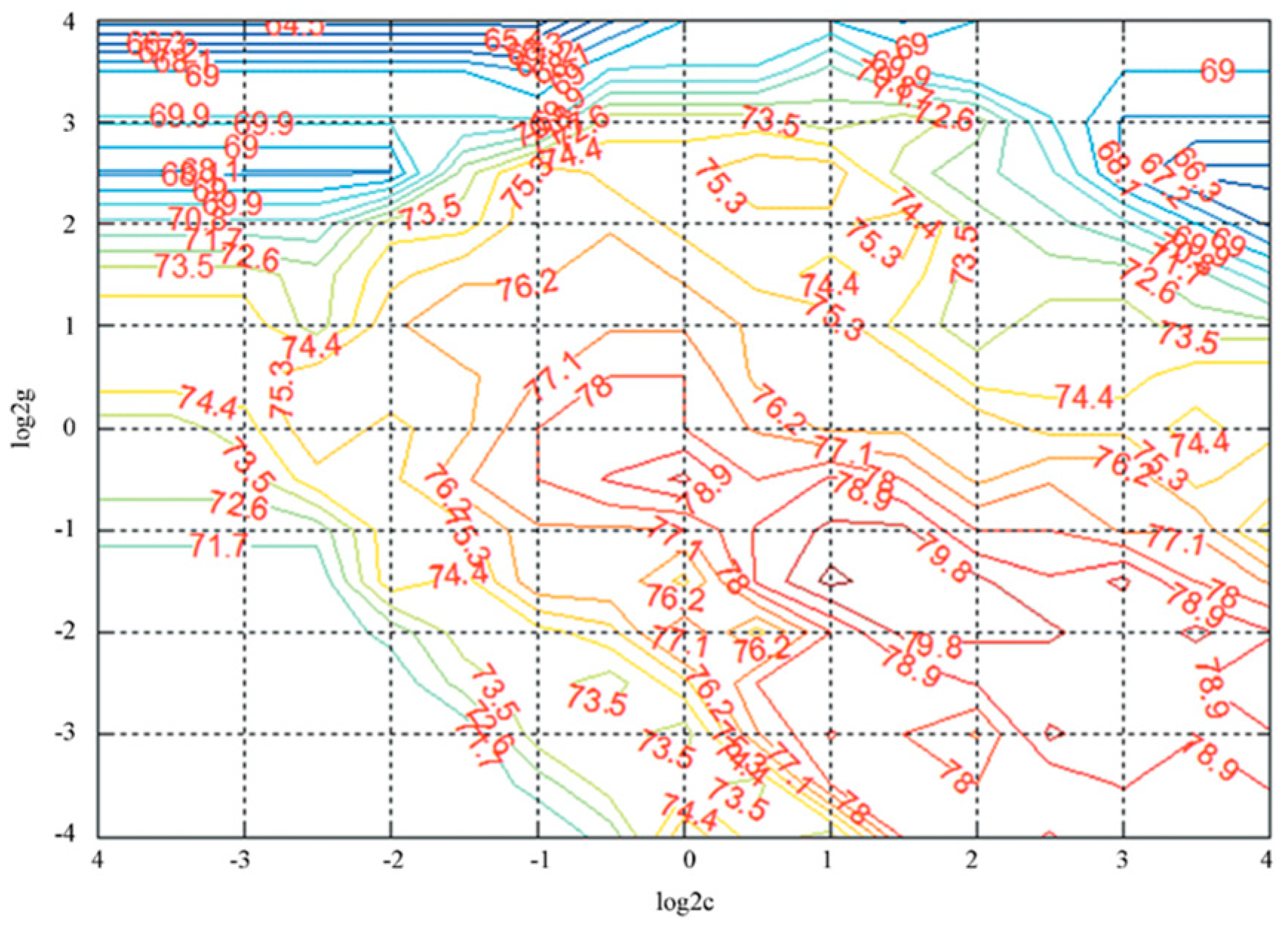

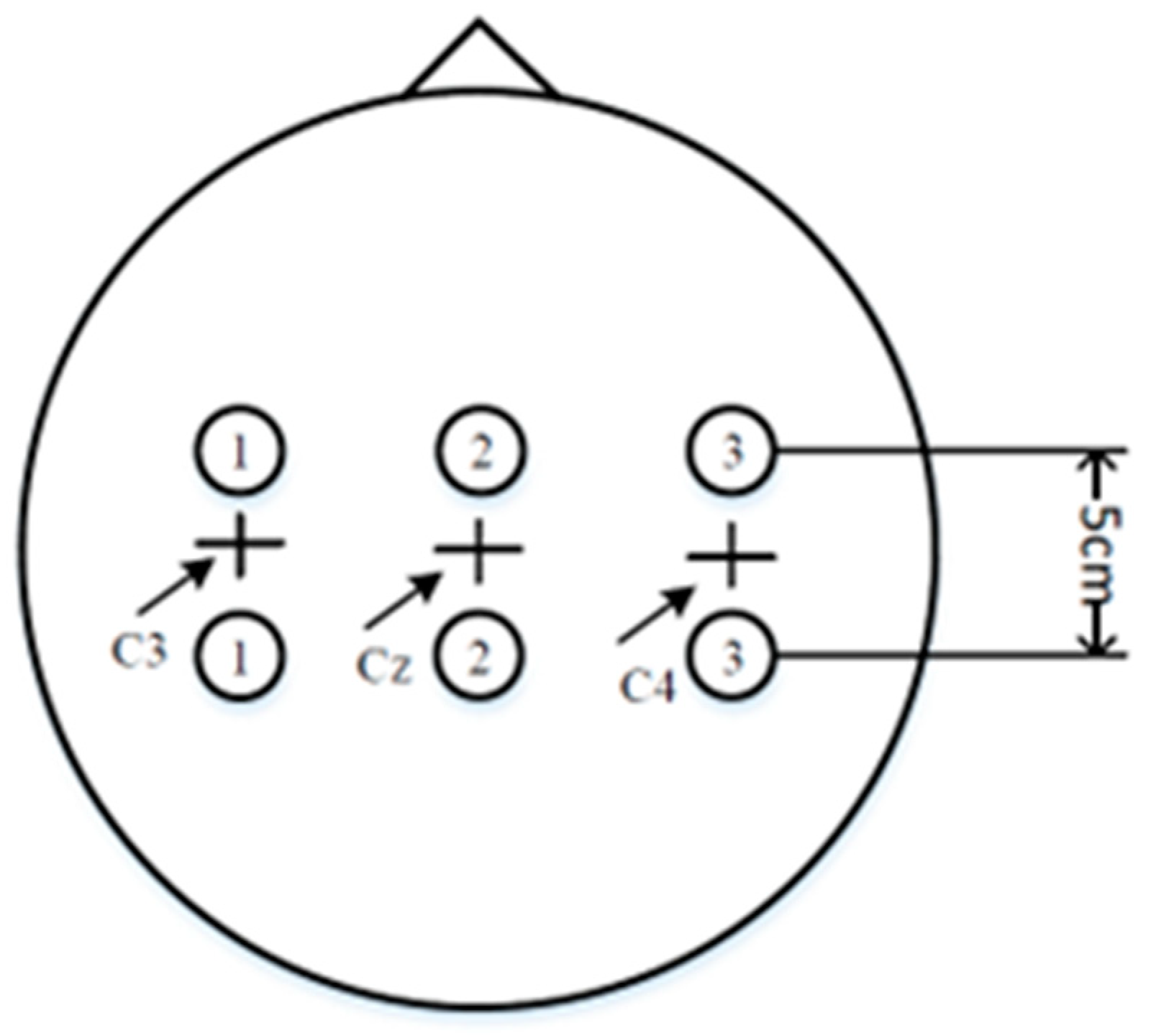
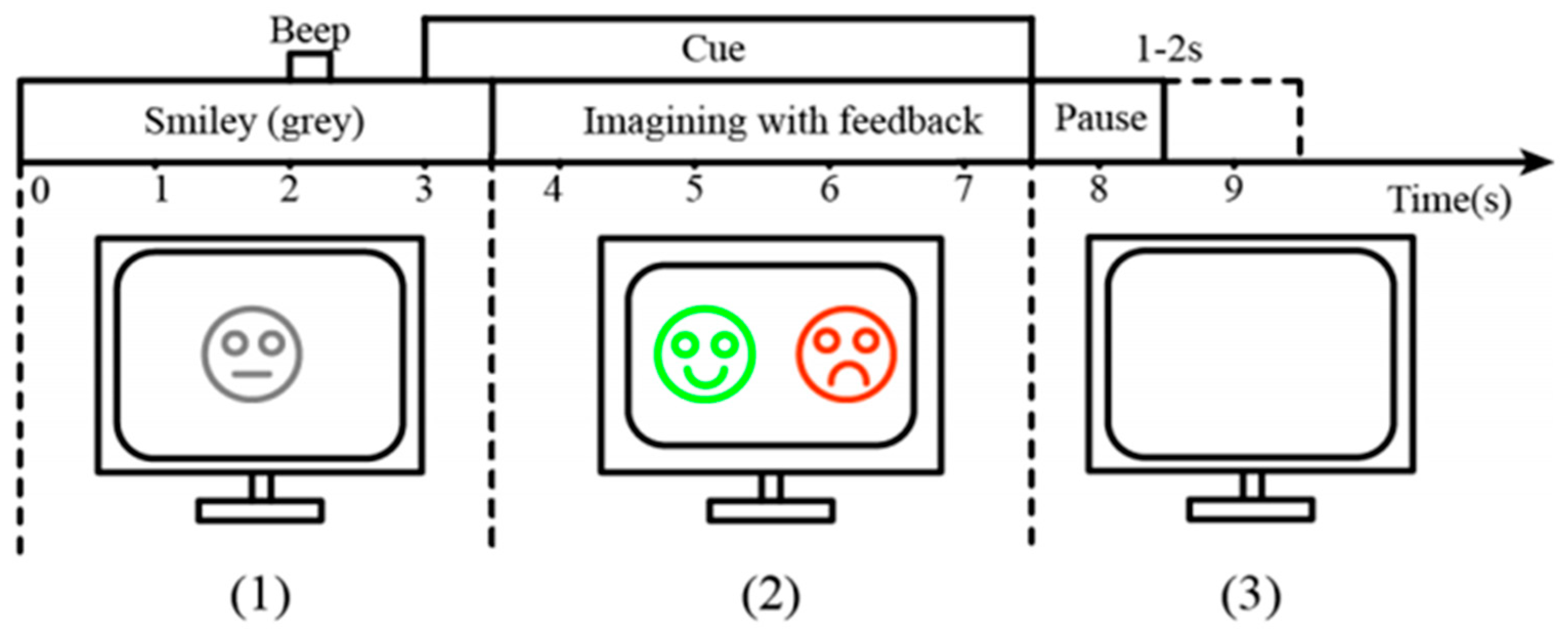

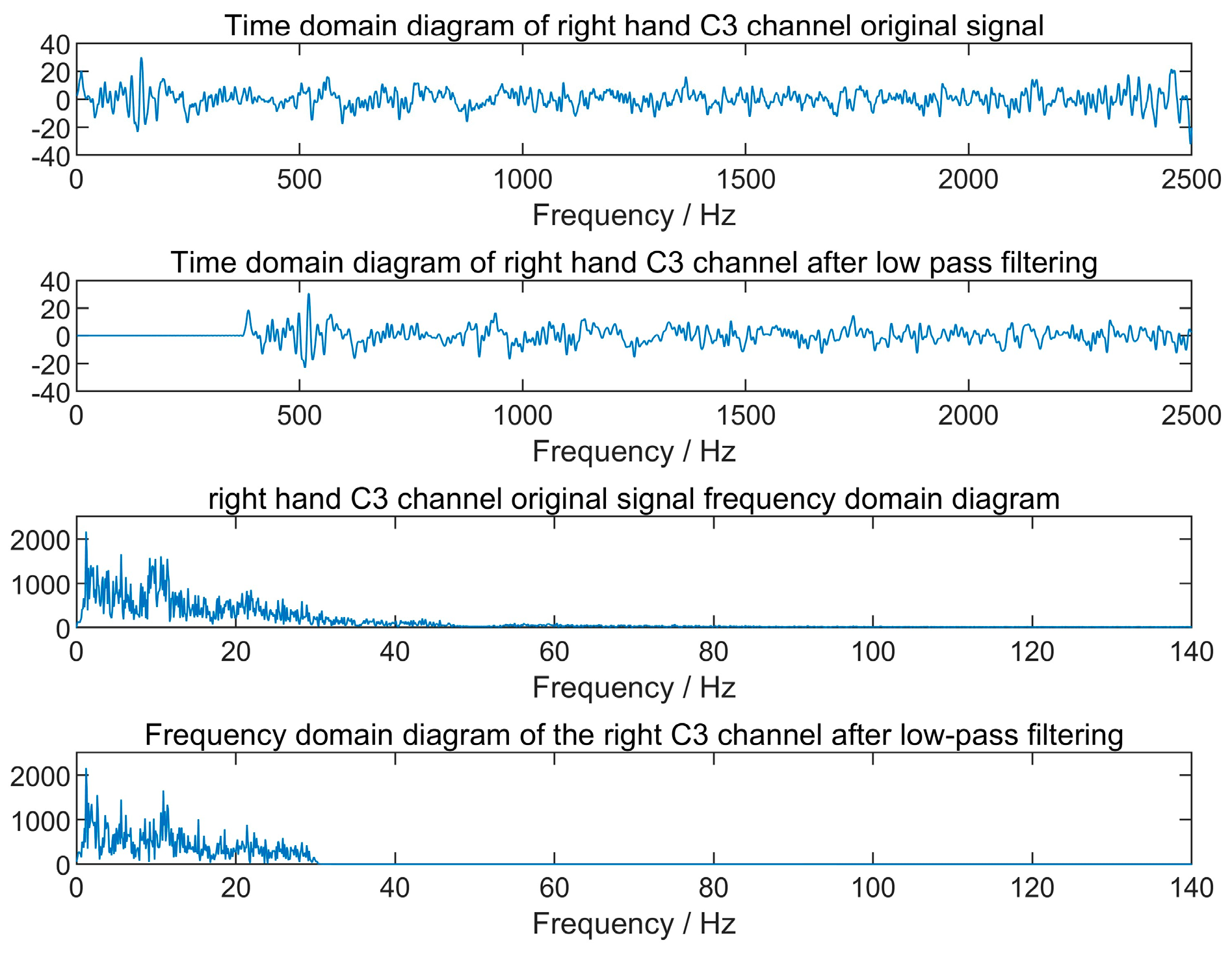
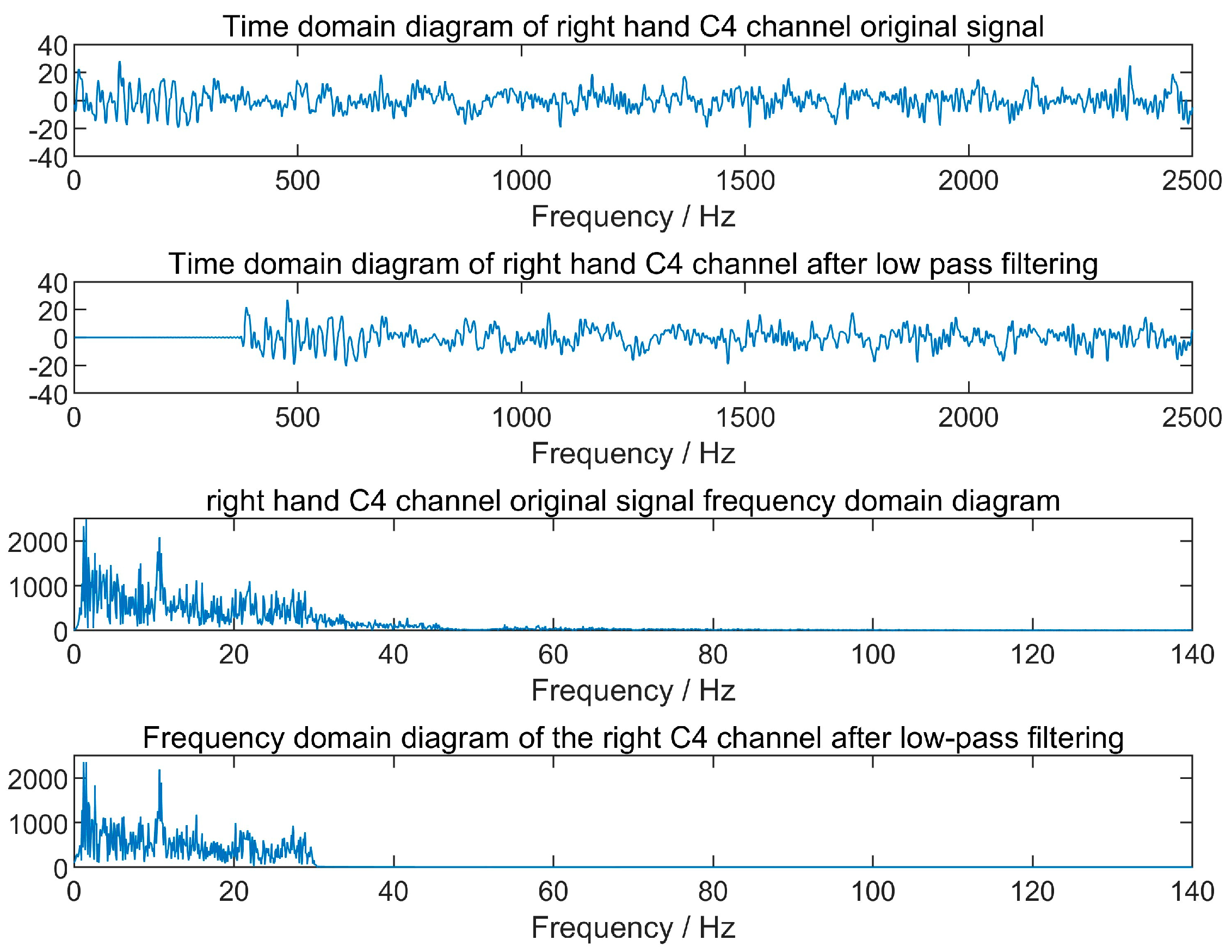


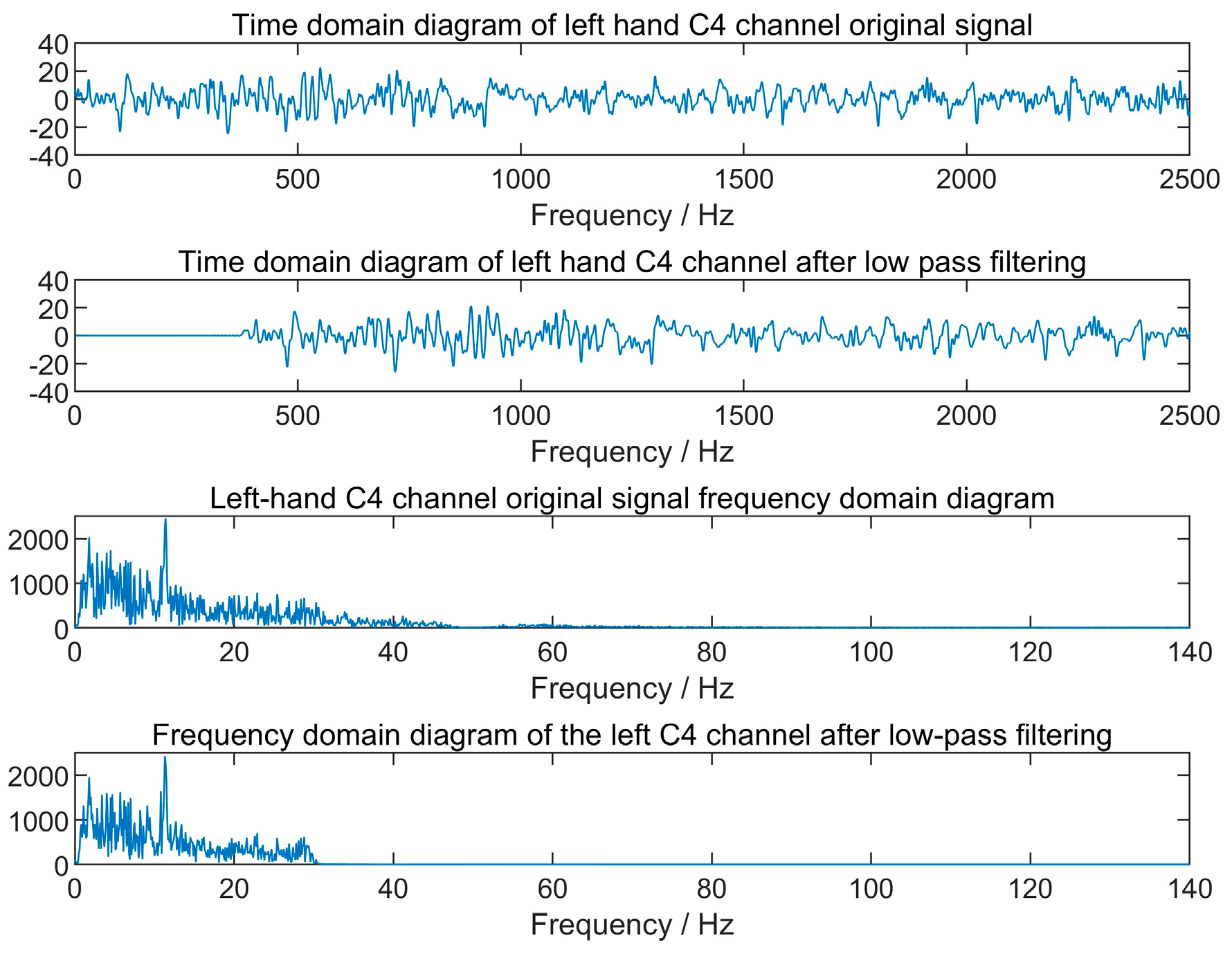
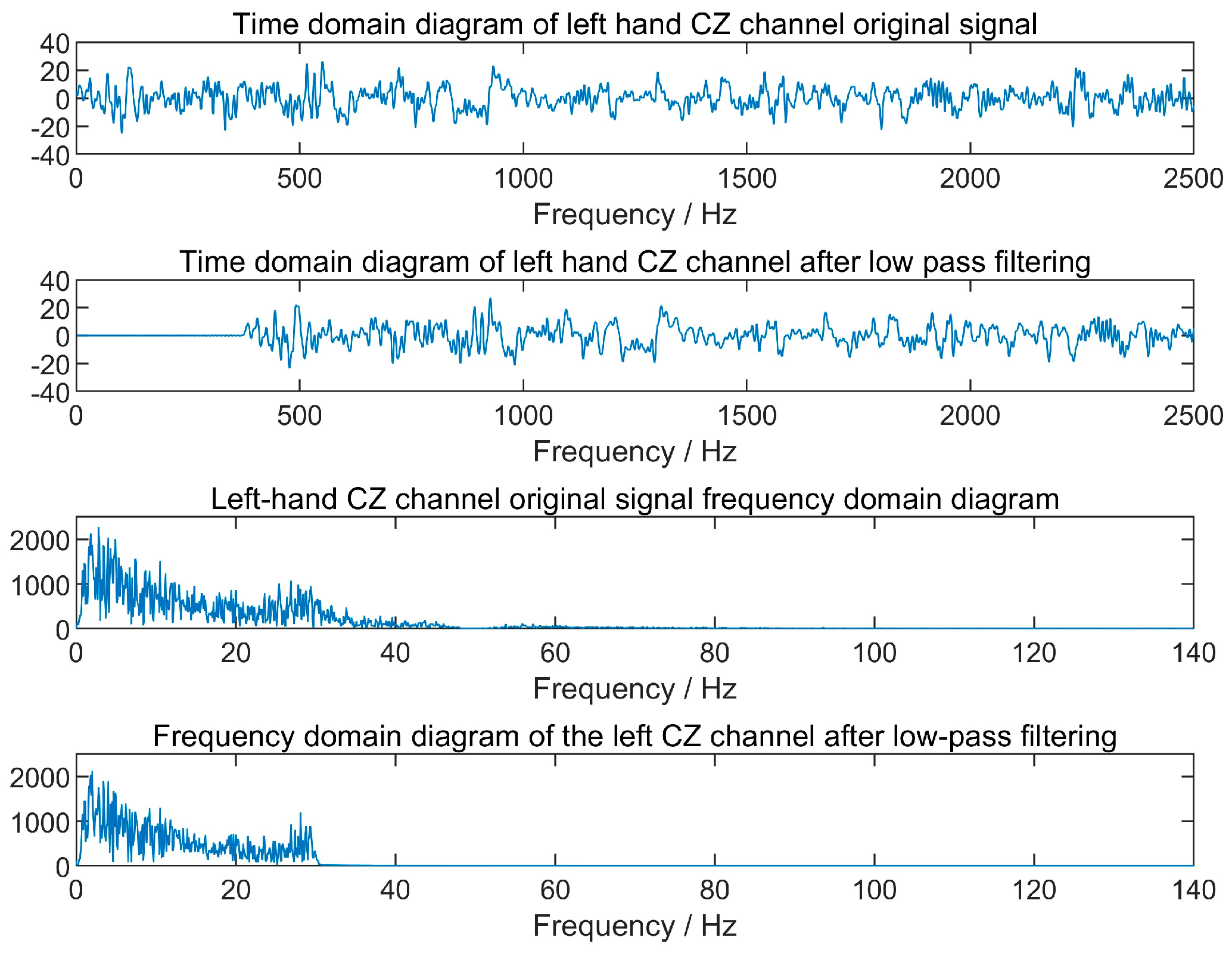
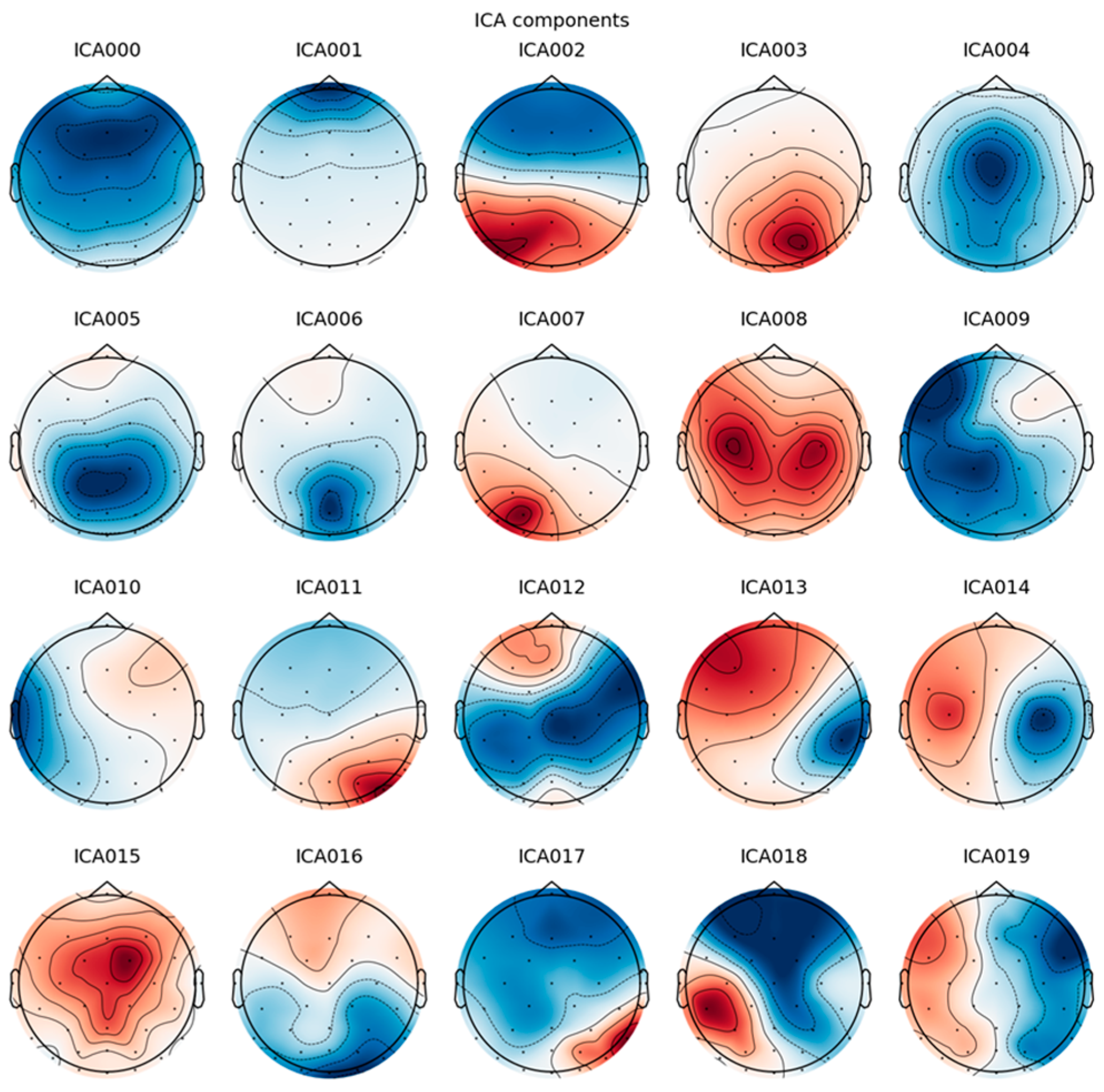


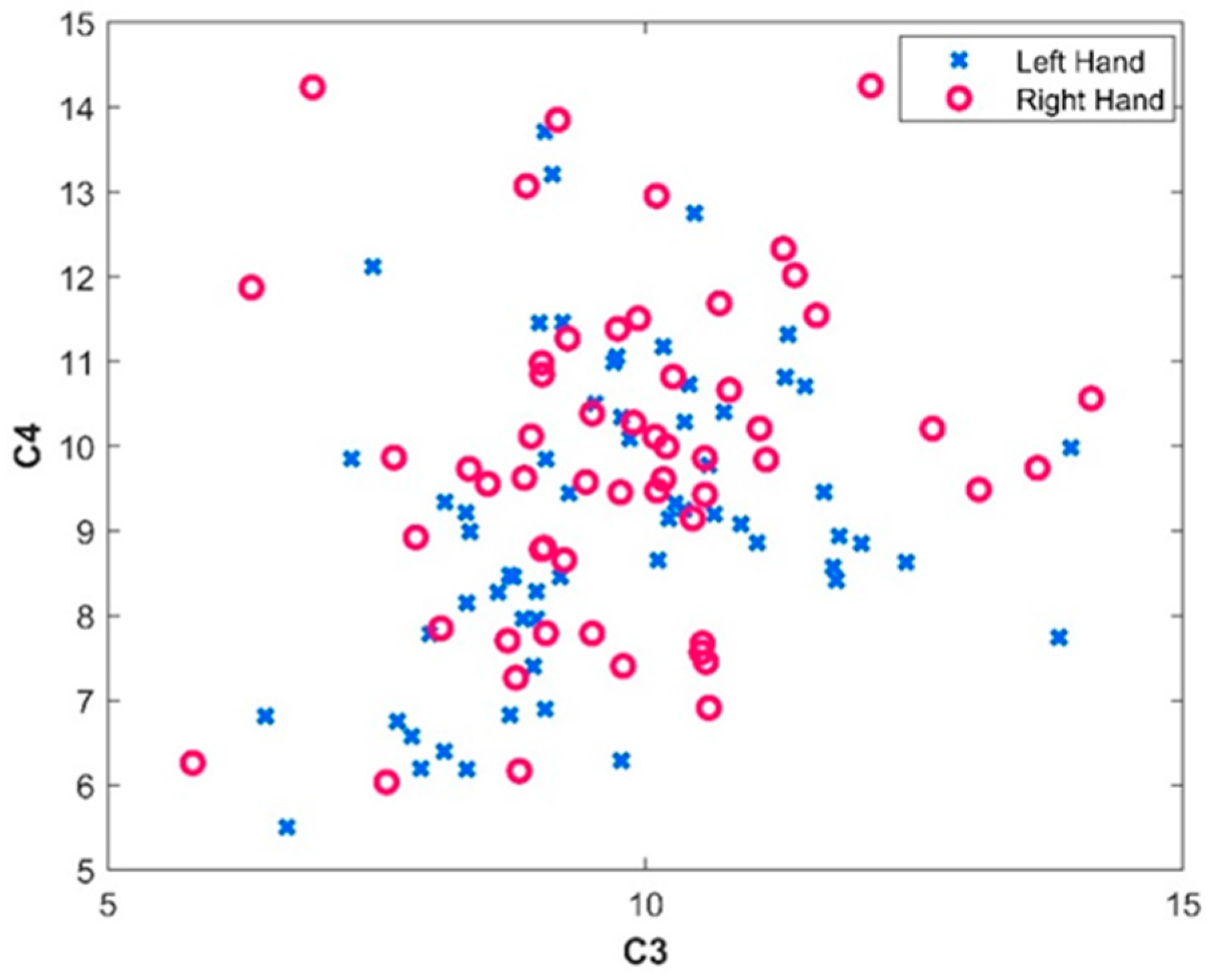



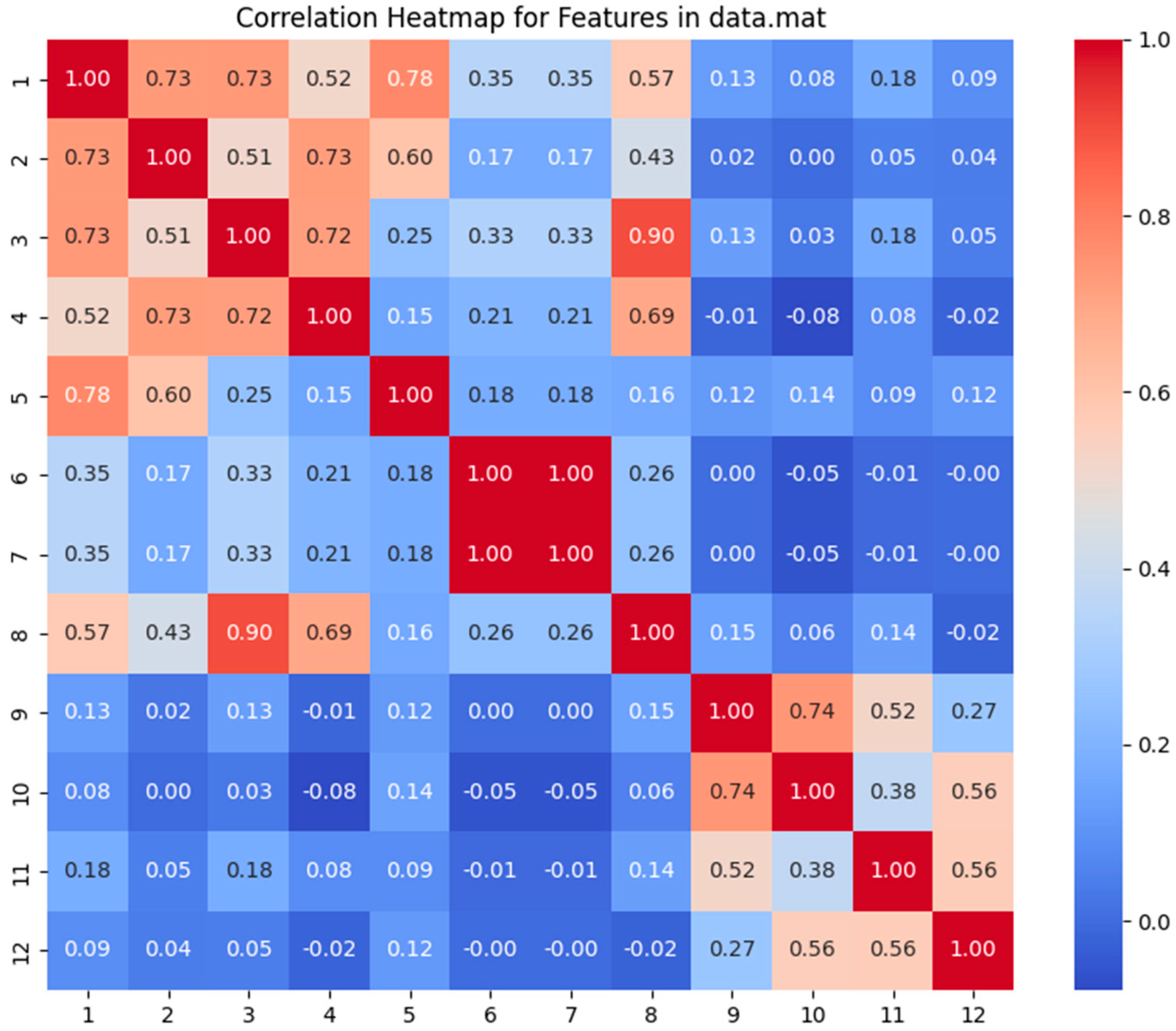

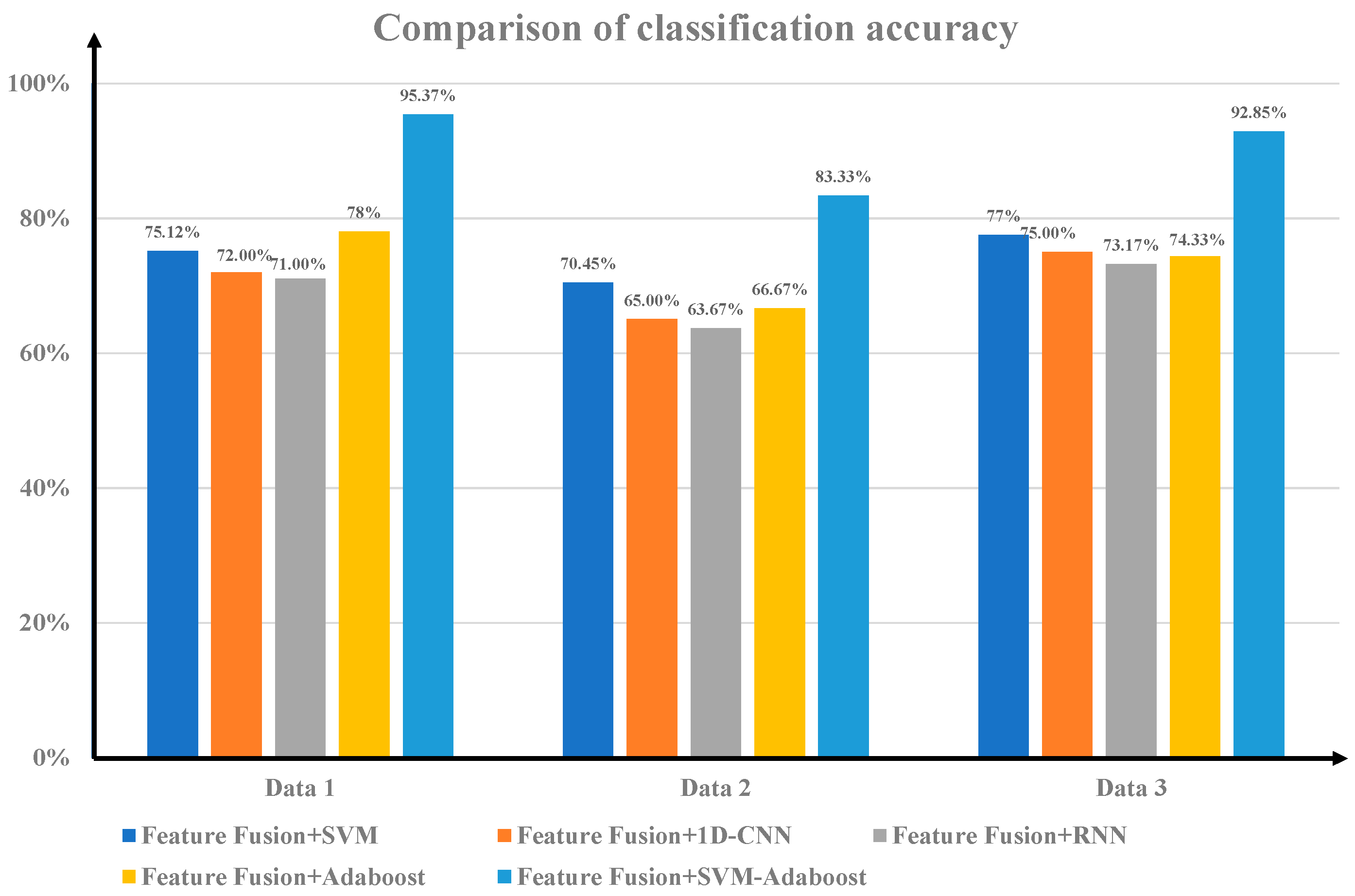
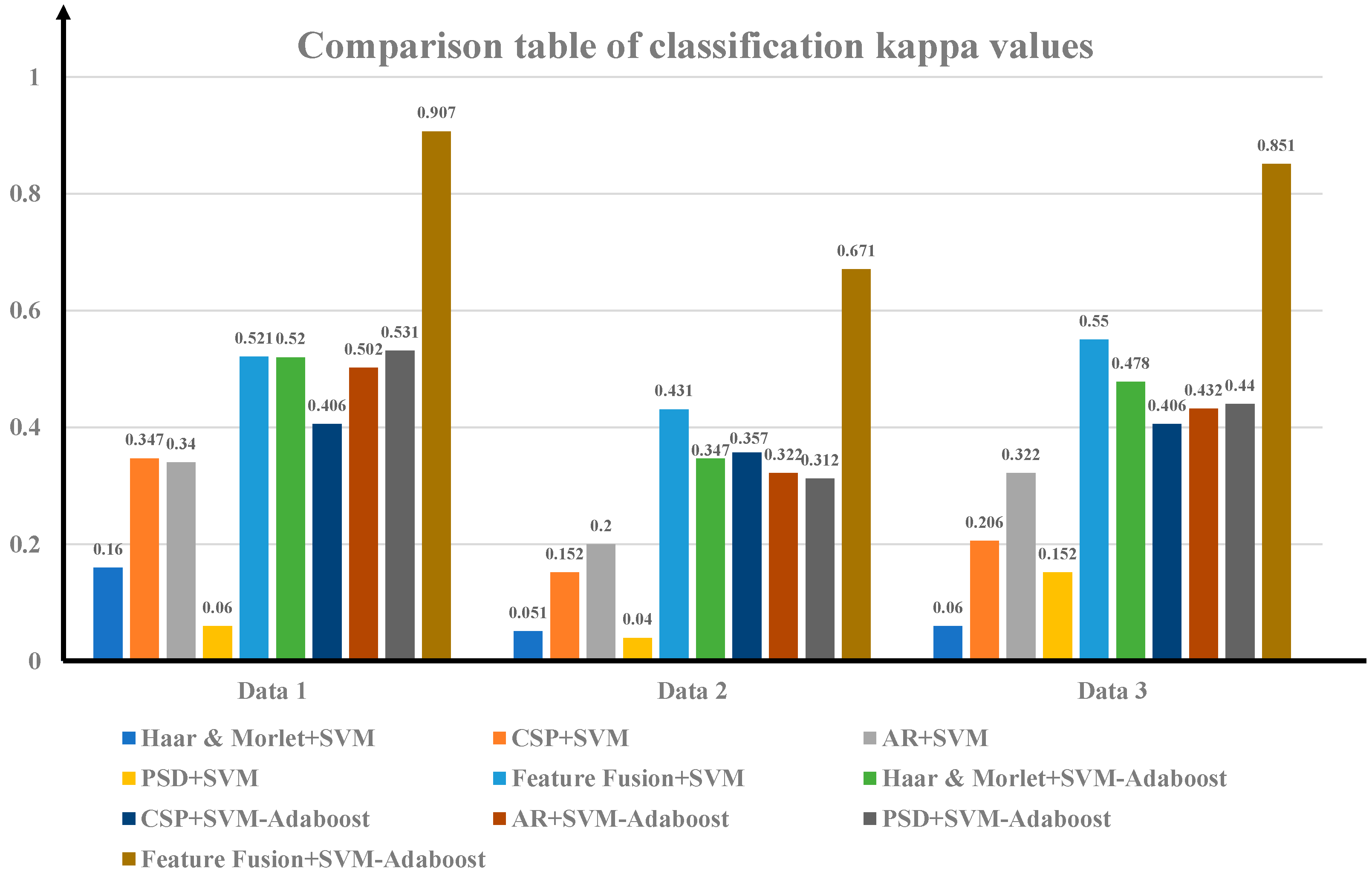
| Decomposed Signal | Frequency Range (HZ) |
|---|---|
| A1 | 32~64 |
| D1 | 16~32 |
| D2 | 8~16 |
| D3 | 0~8 |
| Method | Haar & Morlet | Haar | Morlet | Db4 |
|---|---|---|---|---|
| Data 1 | 54.18% | 50.82% | 50.83% | 49% |
| Data 2 | 49.17% | 47.33% | 48.67% | 46.67% |
| Data 3 | 50% | 48.17% | 47.17% | 43.33% |
| Data 1 | Data 2 | Data 3 | |
|---|---|---|---|
| Haar & Morlet | 75% | 69.13% | 74% |
| CSP | 70% | 69% | 70% |
| AR | 72.70% | 70% | 71.67% |
| PSD | 76% | 67% | 72% |
| Haar & Morlet + CSP | 73.60% | 71.30% | 76% |
| Haar & Morlet + AR | 74.92% | 72.50% | 75% |
| Haar & Morlet + PSD | 77% | 70% | 74.12% |
| CSP + AR | 73% | 69.30% | 72.83% |
| CSP + PSD | 70.12% | 67.20% | 71.64% |
| PSD + AR | 66.90% | 66.70% | 70.16% |
| Haar & Morlet + CSP + AR | 87.13% | 77.80% | 85.20% |
| Haar & Morlet + CSP + PSD | 85.00% | 76% | 83.10% |
| CSP + PSD + AR | 83% | 70.30% | 79.25% |
| Feature Fusion | 95.37% | 83.33% | 92.85% |
Disclaimer/Publisher’s Note: The statements, opinions and data contained in all publications are solely those of the individual author(s) and contributor(s) and not of MDPI and/or the editor(s). MDPI and/or the editor(s) disclaim responsibility for any injury to people or property resulting from any ideas, methods, instructions or products referred to in the content. |
© 2024 by the authors. Licensee MDPI, Basel, Switzerland. This article is an open access article distributed under the terms and conditions of the Creative Commons Attribution (CC BY) license (https://creativecommons.org/licenses/by/4.0/).
Share and Cite
Lu, Y.; Wang, W.; Lian, B.; He, C. Feature Extraction and Classification of Motor Imagery EEG Signals in Motor Imagery for Sustainable Brain–Computer Interfaces. Sustainability 2024, 16, 6627. https://doi.org/10.3390/su16156627
Lu Y, Wang W, Lian B, He C. Feature Extraction and Classification of Motor Imagery EEG Signals in Motor Imagery for Sustainable Brain–Computer Interfaces. Sustainability. 2024; 16(15):6627. https://doi.org/10.3390/su16156627
Chicago/Turabian StyleLu, Yuyi, Wenbo Wang, Baosheng Lian, and Chencheng He. 2024. "Feature Extraction and Classification of Motor Imagery EEG Signals in Motor Imagery for Sustainable Brain–Computer Interfaces" Sustainability 16, no. 15: 6627. https://doi.org/10.3390/su16156627
APA StyleLu, Y., Wang, W., Lian, B., & He, C. (2024). Feature Extraction and Classification of Motor Imagery EEG Signals in Motor Imagery for Sustainable Brain–Computer Interfaces. Sustainability, 16(15), 6627. https://doi.org/10.3390/su16156627






